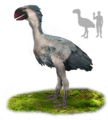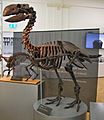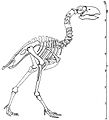Gastornis facts for kids
Quick facts for kids GastornisTemporal range: Upper Palaeocene – Lower Eocene
|
|
|---|---|
 |
|
| Gastornis skeleton | |
| Scientific classification | |
| Kingdom: | |
| Phylum: | |
| Class: | |
| Subclass: | |
| Order: |
†Gastornithiformes
|
| Family: |
†Gastornithidae
|
| Genus: |
†Gastornis
Hébert, 1855
|
Gastornis, once known as Diatryma, was a huge flightless bird that is now extinct. These amazing birds lived a very long time ago, during the late Paleocene and early Eocene periods. The first bones of Gastornis were found in the mid-1800s.
Later, in the 1870s, a famous American paleontologist named Edward Drinker Cope found more complete fossils in North America. He gave them the name Diatryma.
Fossils of these birds have been discovered in parts of Europe, like England, Belgium, France, and Germany, as well as in North America. Scientists are still debating what these birds ate and how they lived.
Contents
What Gastornis Looked Like
The most common type, Gastornis parisiensis, usually stood about 1.75 meters (5.7 feet) tall. But some really big ones could reach up to 2 meters (6.6 feet) tall! That's taller than most grown-ups.
Gastornis had a very large beak that was slightly hooked at the top. This made some scientists think it might have eaten meat. It also had strong, powerful legs and big feet with small claws. However, some fossil footprints suggest that Gastornis might have eaten plants instead.
Where Gastornis Lived
Even though North America and Europe are far apart today, they were much closer when Gastornis lived. Scientists believe there must have been a "land bridge" connecting them. This is why very similar Gastornis fossils have been found on both continents. Other ancient birds and mammals also lived on both sides of the Atlantic during the Paleocene and Eocene periods. This shows that Europe and North America were once connected by dry land.
What Gastornis Ate
When Gastornis was alive, the areas where it lived were covered in thick forests. The climate was warm and moist, like a subtropical or even tropical region today.
Scientists have different ideas about what Gastornis ate:
- Predator: Some think Gastornis was a hunter. Its huge beak could have been used to catch and kill prey. However, some experts doubt it was fast enough to chase quick animals. It might have been an ambush hunter, waiting to surprise its prey, or perhaps hunted in groups.
- Scavenger or Herbivore: Others believe Gastornis might have been a scavenger (eating dead animals), an omnivore (eating both plants and animals), or even a herbivore (eating only plants). Its large beak would have been good for crushing seeds or tearing off tough plants. But the beak seems very strong for just a plant-based diet.
The beak might also have been used for showing off to other Gastornis birds, but since all known fossils have this large beak, it probably wasn't just for mating displays. Because of these different ideas, we don't know for sure what Gastornis ate.
Other giant birds from that time include the terror birds of South America, which were definitely meat-eaters, and the Australian mihirungs, which might have been predators too. Today, large flightless birds like ratites (ostriches, emus) eat plants, small animals, and insects.
Gastornis was one of the biggest birds alive during its time. It probably didn't have many natural enemies or rivals. If these huge birds were active hunters, they would have been important predators, ruling the forests of North America and Europe.
However, around the middle Eocene, new types of large mammal predators appeared in Europe and North America. These new predators might have hunted in packs. The rise of these mammals seems to match the time when Gastornis started to disappear. Birds might not have been able to evolve to be as big as some mammals, which could have made it harder for them to compete.
Gastornis Eggs
Scientists have found pieces of very large eggs in Spain and France that are believed to be from Gastornis. These egg fragments were found in rocks from the late Paleocene and early Eocene periods.
Some pieces were big enough to show that the eggs were about 24 by 10 centimeters (about 9.5 by 4 inches). Their shells were about 2.3–2.5 millimeters thick. This means a Gastornis egg was about one and a half times bigger than an ostrich egg! They also had a different shape, being less round than ostrich eggs.
Large Birds
Images for kids
-
Life restoration of G. steini (now G. gigantea) with outdated, ratite-like plumage, 1917
-
Drawing of probable Gastornis feather from the Green River Formation. By Darren Naish
See also
 In Spanish: Gastornis para niños
In Spanish: Gastornis para niños








